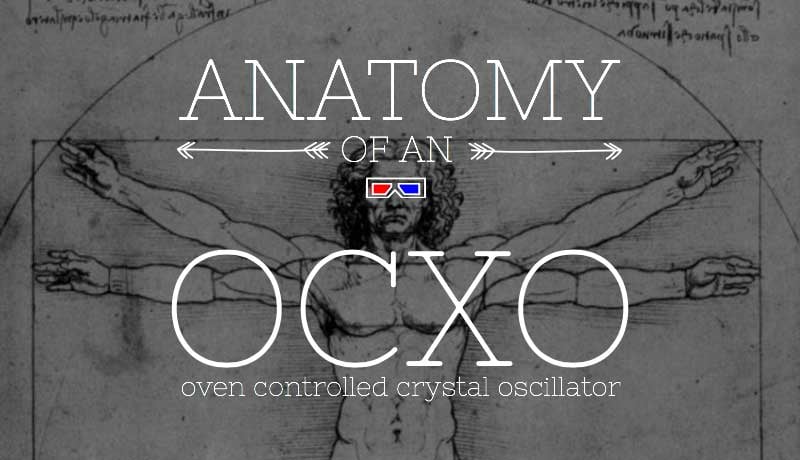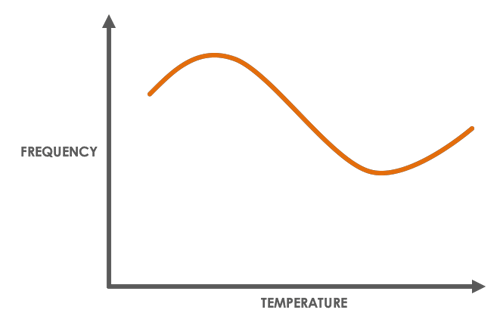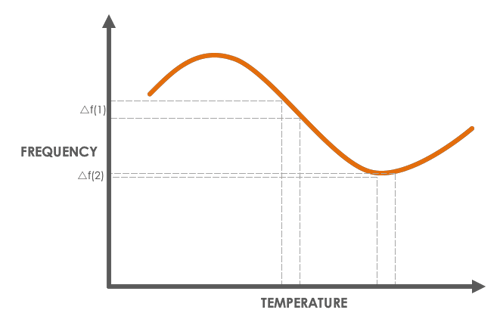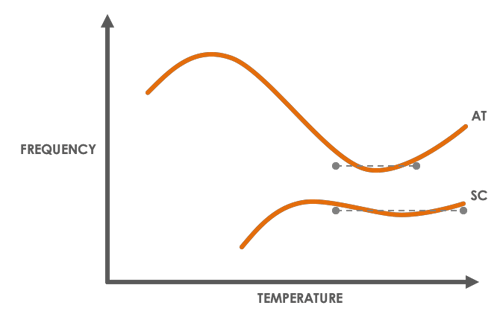
The oven controlled crystal oscillator (OCXO) is near the top of the food chain when it comes to quartz-based frequency control devices, superseded only by the mighty double oven crystal oscillator (DOCXO).
In this blog, we'll review the basics of how an OCXO works, the terms you need to know, how to determine the turning point, and the differences between AT and SC crystal cuts.
Oven Controlled Crystal Oscillator (OCXO) Basics
An OCXO is a temperature-controlled device that maintains a quartz crystal's constant operating temperature. This prevents changes in the specified frequency due to variations in ambient temperature.
The frequency output of a crystal oven is dependent on the temperature of the quartz crystal. You can see in the figure below that temperature can have a significant impact on the frequency of an oscillator.

In most applications, a simpler temperature compensated crystal oscillator (TCXO) can be used to reduce the negative effects of ambient temperature changes. But there are environments where a TCXO just can’t meet the stability requirements of the application. In these cases, RF engineers can take advantage of the OCXO's improved stability.
This improved stability is achieved by maintaining a near constant crystal temperature regardless of the ambient temperature the oscillator is experiencing. Inside an OCXO, there is a heater circuit in addition to the oscillator circuit. This heater circuit can be configured in many different ways, but the most common is a proportionally controlled oven that uses a heating element to heat the crystal and a thermistor to sense the temperature of the crystal.
These elements are part of a bridge network that acts as a closed loop feedback network to hold the temperature of the crystal at a constant. The figure below shows a block diagram of a common OCXO oven control circuit.

Temperature Control: Determining the Turning Point of an OCXO
Keeping the crystal at a constant temperature minimizes the effects of changing ambient temperature and drastically improves the frequency stability of the oscillator. But how do we determine the right set point for the oven?
To do this, we need to look at the relationship between the crystal’s frequency and its temperature a second time. In the graph below, you can see that there is an optimum point on the curve where equal changes in temperature will result in the minimum change in frequency. This is called the turning point of the crystal.

The turning point can be designed by a crystal engineer and is determined by many factors, including things as simple as the angle at which the crystal blank is cut from the bulk quartz material. That being said, each crystal will behave slightly different and the oven set point needs to be finely tuned for each device produced.
When designing the turning point of a crystal, there is a common design trade-off that must be considered. The ideal design goal would be to set the turning point of the crystal above the highest operating temperature of the OCXO. Although the oven can be designed to heat the crystal to a set temperature, if the ambient environment is much hotter, the crystal will heat up beyond its set point .
The downside of pushing the turning point higher is that the frequency vs. temperature curve gets sharper. This narrows the operating window of the oven and makes oven accuracy critical. The other major draw back of pushing the turning point higher is that it reduces crystal aging performance.
Better Crystals, Better Oscillators: AT-Cut vs. SC-Cut
Another option oscillator designers have to increase the performance of their OCXO is to alter the type of crystal inside the oscillator.
Entry-level OCXOs are typically built using AT-cut crystals. These crystals offer good overall performance and are suitable for may applications, but as the turning point needs to be pushed higher, AT-cut crystals run out of steam.
At that point, an SC-cut crystal can be used inside the OCXO to push the turning point higher without sacrificing frequency stability. The frequency vs. temperature curves of AT and SC cut are shown in the figure below. You can see the SC's frequency response is much more uniform over the oven’s operating temperature, which improves stability.

- Improved Frequency Stability: You can see from the graph above that the response of the SC cut is much flatter over a wider temperature range than the AT cut. This translates to tighter frequency stability over temperature.
- Higher Operating Temperature: The turning point of SC cut crystals is higher than that of AT cut crystals, which makes them ideal for ovenized applications. The drawback of this higher turning point is the sharp roll-off at lower temperatures. Because of this trait, SC-cut crystals are only suitable for ovenized oscillators and will not work well in other oscillator configurations (TCXOs, VCXOs, etc.)
- Improved Aging: SC-cut crystals (which stands for “stress compensated”) offer improved aging performance that is 2 to 3 times better than AT cut crystals.
- Warm-up time: An SC-cut OCXO will settle in at its final frequency much faster than a comparable AT-cut OCXO.
- Phase Noise: The SC-cut crystal offers much better Q (quality) factors than AT-cut crystals. As such, the close-in or close to the carrier phase noise of the OCXO is improved.
- G-sensitivity: The stress compensation of the SC-cut crystal also reduces the g-sensitivity of the oscillator. Quartz is a electro-mechanical device, and if you apply a voltage across the crystal, it will oscillate. The downside is that if you apply a vibration across the crystal, it will induce a voltage. This voltage shows up as acceleration or vibration induced phase noise.
Related: Crystal Cut Types: AT vs. SC Cut Performance Comparison
One of the Greatest OCXO Challenges... Solved!
One of the biggest challenges with OCXOs is maintaining excellent frequency stability. Bliley's high-quality, ultra-stable OCXOs offer excellent frequency stability in even the toughest environments.
Need to find the right crystal oscillator for your next project? Explore our full lineup of frequency control products.





